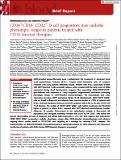Por favor, use este identificador para citar o enlazar a este item:
http://hdl.handle.net/10261/296519COMPARTIR / EXPORTAR:
 SHARE SHARE
 CORE
BASE CORE
BASE
|
|
| Visualizar otros formatos: MARC | Dublin Core | RDF | ORE | MODS | METS | DIDL | DATACITE | |

| Título: | CD34+CD19−CD22+ B-cell progenitors may underlie phenotypic escape in patients treated with CD19-directed therapies |
Autor: | Bueno, Clara; Barrera, Susana; Bataller, Alex; Ortiz-Maldonado, Valentín; Elliot, Natalina; O’Byrne, Sorcha; Wang, Guanlin; Rovira, Montserrat; Gutierrez-Aguera, Francisco; Trincado, Juan L.; González-González, María; Morgades, Mireia; Sorigué, Marc; Bárcena, Paloma; Zanetti, Samanta Romina; Torrebadell, Montse; Vega-García, Nerea; Rives, Susana; Mallo, Mar; Solé, Francesc; Mead, Adam J.; Roberts, Irene; Thongjuea, Supat; Psaila, Bethan; Juan, Manel; Delgado, Julio; Urbano-Ispizúa, Álvaro; Ribera, Josep-Maria; Orfao, Alberto CSIC ORCID ; Roy, Anindita; Menéndez, Pablo | Palabras clave: | Brief Reports Free Research Articles Immunobiology and Immunotherapy Lymphoid Neoplasia |
Fecha de publicación: | 7-jul-2022 | Editor: | American Society of Hematology | Citación: | Blood 140(1): 38-44 (2022) | Resumen: | CD19-directed immunotherapies have revolutionized the treatment of advanced B-cell acute lymphoblastic leukemia (B-ALL). Despite initial impressive rates of complete remission (CR) many patients ultimately relapse. Patients with B-ALL successfully treated with CD19-directed T cells eventually relapse, which, coupled with the early onset of CD22 expression during B-cell development, suggests that preexisting CD34+CD22+CD19− (pre)-leukemic cells represent an “early progenitor origin-related” mechanism underlying phenotypic escape to CD19-directed immunotherapies. We demonstrate that CD22 expression precedes CD19 expression during B-cell development. CD34+CD19−CD22+ cells are found in diagnostic and relapsed bone marrow samples of ∼70% of patients with B-ALL, and their frequency increases twofold in patients with B-ALL in CR after CD19 CAR T-cell therapy. The median of CD34+CD19−CD22+ cells before treatment was threefold higher in patients in whom B-ALL relapsed after CD19-directed immunotherapy (median follow-up, 24 months). Fluorescence in situ hybridization analysis in flow-sorted cell populations and xenograft modeling revealed that CD34+CD19−CD22+ cells harbor the genetic abnormalities present at diagnosis and initiate leukemogenesis in vivo. Our data suggest that preleukemic CD34+CD19−CD22+ progenitors underlie phenotypic escape after CD19-directed immunotherapies and reinforce ongoing clinical studies aimed at CD19/CD22 dual targeting as a strategy for reducing CD19− relapses. The implementation of CD34/CD19/CD22 immunophenotyping in clinical laboratories for initial diagnosis and subsequent monitoring of patients with B-ALL during CD19-targeted therapy is encouraged. | Versión del editor: | http://dx.doi.org/10.1182/blood.2021014840 | URI: | http://hdl.handle.net/10261/296519 | DOI: | 10.1182/blood.2021014840 | Identificadores: | doi: 10.1182/blood.2021014840 issn: 0006-4971 e-issn: 1528-0020 |
| Aparece en las colecciones: | (IBMCC) Artículos |
Ficheros en este ítem:
| Fichero | Descripción | Tamaño | Formato | |
|---|---|---|---|---|
| CD34_Bueno_PV_Art2022.pdf | 4,49 MB | Adobe PDF |  Visualizar/Abrir |
CORE Recommender
SCOPUSTM
Citations
19
checked on 29-abr-2024
WEB OF SCIENCETM
Citations
15
checked on 20-feb-2024
Page view(s)
27
checked on 30-abr-2024
Download(s)
22
checked on 30-abr-2024
Google ScholarTM
Check
Altmetric
Altmetric
Este item está licenciado bajo una Licencia Creative Commons

